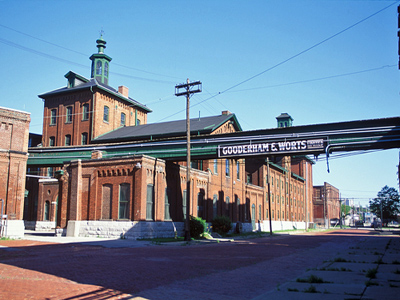Gooderham and Worts Distillery National Historic Site of Canada
Toronto, Ontario

General view
© Parks Canada Agency / Agence Parcs Canada.
Address :
Trinity Street, Toronto, Ontario
Recognition Statute:
Historic Sites and Monuments Act (R.S.C., 1985, c. H-4)
Designation Date:
1988-11-11
Dates:
-
1859 to 1927
(Construction)
Event, Person, Organization:
-
Gooderham and Worts
(Organization)
-
David Roberts, Sr / Gundry and Langley
(Architect)
Other Name(s):
-
Gooderham and Worts Distillery
(Designation Name)
-
Distillery District
(Other Name)
Research Report Number:
2004-SDC/CDE-024, 1988-038
Plaque(s)
The seeds of Canada's largest 19th-century distilling firm were sown in 1837 when a still was set up on this site to convert surplus grain from an 1832 grist mill into whisky. Exploiting new technologies and commercial opportunities, Gooderham and Worts grew steadily, parallelling Toronto's rise as a manufacturing centre. With the large stone distillery erected in 1859-61 and brick malthouse, kilns, warehouses, shops and offices built before 1900, this complex is an outstanding example of Victorian industrial design in terms of integrity, historical associations and aesthetic qualities.
Description of Historic Place
The Gooderham and Worts Complex includes 30 brick and stone industrial buildings, some of which are attached to one another, located on 13 acres of land at the intersection of Trinity and Mill streets on the eastern edge of downtown Toronto. The buildings were constructed between 1859 and 1927 to produce, package, store, market and develop spirits for the Gooderham and Worts firm. The formal recognition consists of the buildings on their property at the time of designation.
Heritage Value
The Gooderham and Worts Complex was designated as a site of national historic and architectural importance because: it is an imposing landmark, containing a number of buildings that collectively bear witness to the evolution of the Canadian distilling industry.
The heritage value of the Gooderham and Worts Complex resides in the unique sense of history and place created by: the completeness of the complex in illustrating the entire distillery process, from the processing of raw materials, to the storage of finished products for export; the physical evidence that it provides about the history of Canadian business, the distilling industry and 19th-century manufacturing processes; the architectural cohesiveness of the site characterized by a high degree of conformity in the design, construction and craftsmanship of its constituent buildings; and the physical relationships among the buildings and between the site and the railway to the south.
Sources: Historic Sites and Monuments Board of Canada, Minute, 1988.
Character-Defining Elements
Elements which characterize the heritage value of this building include: existing spatial arrangement of the buildings on the site arrayed along lanes and streets; industrial skyline of pitched roofs, turrets, chimney stacks and parapets; coordinated palette of material and paint colours throughout; large scale of the complex; functional spatial organization, apparent in the rectilinear alignment of buildings along Mill Street; isolation of storage buildings from one another; location of the complex adjacent to rail line and former shoreline of Toronto Bay; alignment and connection of buildings with one another to create continuous articulated facades, especially those of: the malthouse and office block (buildings 28 and 31-36) and the water tank, still rooms, bottling/mixing room and warehouse (buildings 53-59); unity of design through consistent exterior use of brick, limestone and formal motifs; use of Italianate detailing throughout, including round-arched openings; segmented-arch windows; ordered facades; corbelled brickwork; and symmetrical arrangement of openings and organization of elevations; high level of craftsmanship in the brickwork, stone masonry and timber framing; provision of natural light through the extensive use of multi-pane glazing; survival of numerous functional building types; neoclassical design of the four-storey distillery and mill building (buildings 2-5), with segmented-arched windows; pedimented gable ends, limestone stringcourses, stone quoins, and symmetrically arranged openings; reinforced construction of the distillery building (buildings 2-5) with thick stone walls, metal braces and timber framing; italianate treatment of the malthouse/office block (buildings 28 and 31-36), with façade symmetry, corbelled brickwork, pilasters, and pedimented entrance bay; neoclassical cupola of the of the office building (building 31); solid masonry construction, buttresses, heavy doors, and substantial wooden windows and shutters of the tank houses and warehouses (buildings 42, 43, 44, 47-50, 59, 61-65, 75); massive scale and extensive fenestration of the six-storey rack warehouse (building 42); functional design of the rack warehouse with solid brick walls reinforced with buttresses, punctuated by a highly symmetrical arrangement of segmented-arched windows(building 42); high quality of the masonry of the rack warehouse (building 42), evident in: corbelled brickwork along the cornice; brick voussoirs over each window; brick buttresses; limestone lintels; limestone trim at the foundation; substantial, fortified exterior treatment of the rack warehouse, as evidenced in: iron bars on windows; timber exterior shutters; iron hardware on windows and doors; scale and functional design of the malthouse (buildings 35 and 36), with specialized spaces located on each of its three storeys and its attic; interior detailing of the malthouse (buildings 35 and 36), including its small windows, cast-iron columns, roof vents, brick vaults, malting floors, and granary; full-storey multi-paned windows with large transoms on each storey of the west elevations of the pure spirits building block (buildings 53-57 and 61-62); cast-iron facades with the elaborate iron railing on the second storey of the four connected structures comprising the pure spirits building (buildings 53-57 and 61-62); all connecting conveyance ways, for pedestrians and materials, located at the second storey and above; entire complement of supporting buildings in their massing, materials and detailing, including the machine shop (building 8), molasses tank (building 9), cooperage (building 34), steam fitter's shop (building 45), lunch room (building 45a), boiler house (building 46), stable/garage (building 52), bottling/tank house (building 58), pumphouse (building 60) and case warehouse (building 74).